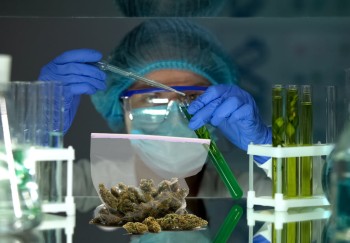 blume.jpg?width=375)
Researchers from the Federal University of Rio de Janeiro (UFRJ) have made a significant discovery in Brazil. They have found cannabidiol (CBD), a compound found in cannabis, in a common Brazilian plant. This finding presents new possibilities for producing CBD, which is becoming increasingly popular.
The scientists have specifically identified a native Brazilian species called 'Trema micrantha (L.) Blume', which belongs to the 'Cannabaceae' family. This shrub, often regarded as a weed, is widely distributed throughout South America and contains only CBD. Molecular biologist Rodrigo Moura Neto provided this information about Trema micrantha (L.) Blume.
Characteristics of 'Trema micrantha.'
Trema micrantha is not your typical plant. Unlike other plants discovered to contain cannabinoids, this unique Brazilian native exclusively contains CBD. This characteristic sets it apart because it offers the potential for CBD production without the legal complexities associated with cannabis, which contains THC, a psychoactive compound.
Also known as the Florida trema, Trema micrantha is a flowering plant belonging to the Cannabaceae family, which includes hemp. It is a fast-growing deciduous tree that can grow up to 10 meters tall. This plant originates from Brazil and is also found in various tropical and subtropical regions worldwide. Renowned for its resilience and adaptability to different soil conditions, it is commonly seen in urban landscapes and utilized in reforestation projects.
Within its natural environments, Trema micrantha fulfils an essential ecological role. Its fruits serve as a nourishment source for numerous bird species, promoting seed dispersal and enhancing biodiversity. The plant's rapid growth and dense foliage offer vital refuge for wildlife, while its roots significantly prevent soil erosion. In urban settings, Trema micrantha is commonly employed in landscaping due to its pleasing aesthetics and capacity to enhance air quality by absorbing pollutants.
In addition to its ecological significance, Trema micrantha holds a history in traditional medicine. The leaves and bark of this plant have been utilized to address a range of ailments, spanning from wounds and skin infections to digestive issues. However, the recent revelation of CBD within Trema micrantha has garnered attention for this natural plant.
CBD, a compound known for its potential health advantages, has gained popularity in treating conditions such as epilepsy, chronic pain, and anxiety. It is one of the primary active components found in cannabis, alongside tetrahydrocannabinol (THC), which is responsible for the psychoactive effects experienced by users.
The medical efficacy of this compound is still being investigated, and ongoing research aims to shed more light on its potential uses. We may discover additional applications for this versatile plant with further exploration, solidifying its position in botanical and medical history.
Overcoming Legal Restrictions
According to Rodrigo Soares Moura Neto, the Institute of Biology (IB) research coordinator at UFRJ, the chemical analysis revealed that "Trema" contains CBD without any traces of THC. This discovery opens up the possibility of a plentiful new source of CBD that would not be hindered by the legal and regulatory obstacles associated with cannabis, which remains illegal in various locations, including Brazil.
Neto explains that Trema micrantha has the potential to be a game-changer. Regarding selling CBD, the National Health Surveillance Agency (Anvisa) imposes restrictions on the formulation, allowing only 0.2% THC content. However, since Trema micrantha is THC-free, this issue is eliminated. Moreover, there would be no legal constraints on cultivating this plant, making it a potentially more accessible and cost-effective source of CBD.
According to Neto, Trema micrantha provides a legal alternative to utilizing cannabis. He highlights that this plant is abundant throughout Brazil, making it a more straightforward and cost-effective source of cannabidiol (CBD). In addition, he mentions that CBD has been previously discovered in a related plant in Thailand, indicating the potential presence of this compound in various plant species worldwide.
The Future is Bright
Neto, who has yet to publish his findings, intends to expand his research and investigate the most effective techniques for extracting CBD from "Trema." Furthermore, he aims to assess the efficacy of CBD in treating patients with conditions currently managed with medical cannabis.
Having recently secured a grant of 500,000 reais (equivalent to US$104,000) from the Brazilian government, his team is now financially supported to conduct the research. Neto anticipates that the study will require a minimum of five years to reach completion.
In an intriguing turn of events in the captivating tale of Trema micrantha: this very plant has already established itself across Brazil. Yes, it's true! An unsuspected CBD industry game-changer has been quietly flourishing right under our noses.
The revelation of Trema micrantha's existence carries immense implications for the CBD industry. With a legal and easily accessible source of CBD now at hand, we might witness a surge in CBD product manufacturing and utilization, potentially bringing relief and advantages to countless individuals worldwide.
The emergence of Trema micrantha heralds a promising future for the CBD industry. As ongoing research unfolds, we can anticipate exciting advancements and breakthroughs in CBD, paving the way for new possibilities and innovations.
According to a study conducted by Vantage Market Research last year, the global CBD market was valued at nearly US$5 billion, with projections indicating growth to surpass US$47 billion by 2028. This expansion is primarily attributed to the increasing adoption of CBD for health and wellness purposes.
Conclusion
The discovery of CBD in the Brazilian plant Trema micrantha brings new possibilities to the CBD industry. Trema micrantha, a common and abundant plant in Brazil, offers a legal and readily available source of CBD without the legal complexities associated with cannabis. This finding has sparked interest in the potential health benefits of CBD, and ongoing research aims to explore its efficacy in treating various conditions.
Rodrigo Moura Neto and his Federal University of Rio de Janeiro team have secured a grant to investigate further CBD extraction from Trema micrantha and its effectiveness in medical applications. With the global CBD market projected to reach over $47 billion by 2028, this discovery holds significant promise for the industry.
By overcoming legal restrictions and providing a cost-effective source of CBD, Trema micrantha has the potential to revolutionize CBD production and benefit individuals worldwide. Exciting advancements and innovations are expected as research in this field progresses, solidifying the bright future of CBD.

_Blume.jpg?width=800)





